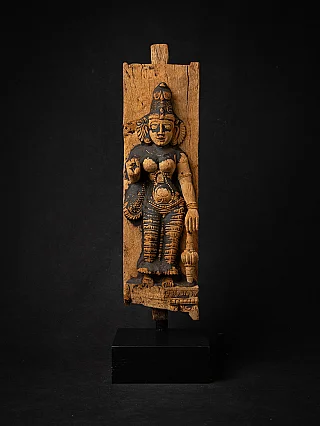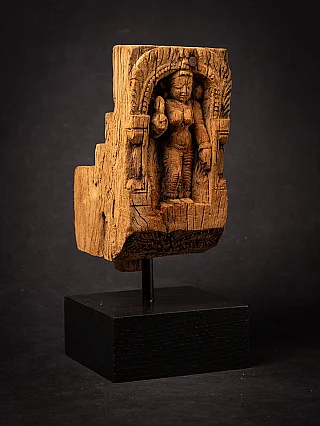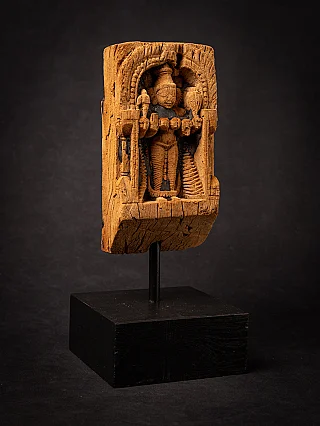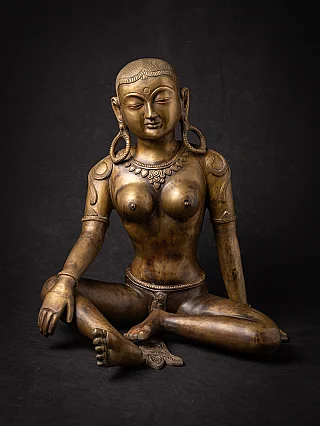Parvati Statues
Author : Peter Vredeveld

In Hinduism, Parvati is one of the most worshipped Goddess since she blessed all beings and destroys all evil.
Exclusive collection of Hindu gods statues
Parvati, an integral figure in Hinduism, radiates as a symbol of profound concepts such as love, fertility, and devotion. With the divine trinity of Shiva, Lakshmi (the Goddess of prosperity and wealth), and Saraswati (the Goddess of knowledge and learning), Parvati's significance is intricately entwined. Millions of devotees hold Parvati in the highest esteem, attributing to her benevolence, her instrumental role in combating evil, and her extraordinary ability to bestow blessings with unwavering grace.
The Essence of Parvati
At the core of Hinduism, Parvati holds a significant place among the key figures of the divine trinity, including Lakshmi and Saraswati. This trinity represents the foundational aspects of human existence—prosperity, knowledge, and the divine feminine energy embodied by Parvati. She epitomizes the essence of love, fertility, and devotion, elements deeply ingrained in Hindu spirituality.
Cosmic Dance of Creation and Destruction

As the second consort of Lord Mahadev (Shiva), Parvati's journey intricately intertwines with the cosmic dance of creation and destruction orchestrated by Shiva. This cosmic dance is not merely a symbolic act but a fundamental force shaping the universe's eternal cycles of birth, existence, and dissolution. Parvati's role as Shiva's consort underscores her involvement in this intricate cosmic tapestry, where her presence represents the nurturing and sustaining aspect of the divine feminine in the grand cycle of existence.
The Shakti of the Universe
Parvati is more than just a deity and is closely associated with Shakti, the universal feminine energy that breathes life into the cosmos. Shakti is the dynamic force that animates all living beings, and Parvati, in her role, symbolizes the nurturing and sustaining aspect of this cosmic energy. She embodies the divine feminine principle, representing the eternal, creative power of the universe, ensuring its continuous growth and renewal.
The Different Names and Forms of Parvati
Parvati assumes various names and forms, known as Dasamahavidyas, each with unique significance. These forms represent her multifaceted power and knowledge:
1. Goddess Kali

Goddess Kali is a fearsome and powerful form of Parvati, often depicted with a dark complexion, multiple arms, and a garland of skulls. Kali represents the destructive aspect of the divine feminine and is associated with the overcoming of evil forces.
2. Goddess Tara
Tara is a compassionate and serene form of Parvati. She depicts with a gentle demeanor, often seated in a meditative posture. Tara represents the nurturing and protective aspect of the divine mother.
Extremely precious one of a kind statues collection
3. Bhuvanevari
Vidya Bhuvanevari is a form of Parvati associated with knowledge and learning. She embodies wisdom, education, and the intellectual aspects of the divine feminine.
4. Sadasi
Sadasi is a form of Parvati representing the eternal and unchanging nature of the divine. She symbolizes the timeless and unmanifested aspect of the cosmos.
5. Dhumavati
Dhumavati is a widow goddess, often depicted as an old and unattractive figure. She symbolizes the hardships and challenges in life and the ability to transcend them with inner strength.
6. Bhairavi
Bhairavi is a fierce and formidable form of Parvati. She represents the power and courage to overcome adversity. Bhairavi's name derives from the word "Bhairava," which means terror or awe.
7. Vidya Chinnamasta
Chinnamasta is a striking form of Parvati. People depict her as a goddess who beheads herself, and her severed head feeds her blood to her two attendants. This form symbolizes sacrifice and selflessness.
8. Vidya Kamala
Kamala is a form of Parvati associated with wealth, prosperity, and abundance. She represents the material and financial aspects of life with lotus flowers.
9. Vidya Bagala
Bagala is a protective form of Parvati. She is depicted with a fierce demeanor, holding weapons to ward off evil forces and protect her devotees.
10. Matangi
Matangi is a form of Parvati associated with the arts and creative expression. She embodies the power of music, speech, and the finer aspects of culture.
These various forms of Parvati highlight her multifaceted nature and diverse roles in the cosmic order, from the nurturing and protective mother to the fierce and powerful destroyer of evil.
The Connecting Force
In the grand tapestry of Hindu belief, Parvati is the primary connecting force for all beings and serves as the medium for their spiritual release. Her divine presence fosters a sense of connection and unity among worshippers, making her a beacon of hope, inspiration, and spiritual guidance. Through her love and devotion, she unites the spiritual aspirations of those who seek her blessings.
Historical Context
The worship of Parvati can be traced back to ancient times, with references found in sacred Hindu texts like the Puranas. Her transformation from being the daughter of the Mountain King Parvat and Queen Mena to her role as a mother of deities signifies her evolving significance over the ages. This historical context underscores her enduring importance in the evolution of Hindu mythology and the cultural tapestry of India, marking her as an ever-evolving symbol of devotion and motherhood.
Shiva and Shakti: The Divine Union
At the heart of Hindu spirituality lies the profound concept of Shiva and Shakti, an exquisite fusion of the divine masculine and feminine energies. This union represents the timeless harmony and balance in the universe, emphasizing the inseparable interplay between the two forces, without which creation and existence would be incomplete. The dynamic dance of Shiva and Shakti symbolizes the fundamental principles of creation, preservation, and destruction.
Historical Evolution
The concept of Shiva and Shakti has evolved over millennia, reflecting the dynamic nature of Hindu spirituality. The understanding of these divine principles has adapted and expanded with changing times, demonstrating the flexibility and resilience of Hindu religious thought. Shiva and Shakti inspire seekers and devotees on their spiritual journeys, reminding them of the divine union's eternal significance.
The Divine Offspring: Ganesha and Kartikeya

Parvati's role as a mother is a central facet of her divine nature. The stories of her children, Ganesha and Kartikeya, have been passed down through generations, highlighting Parvati's importance in Hindu mythology and emphasizing the profound love and motherly care she bestows upon her offspring. Ganesha, the elephant-headed deity, is revered as the remover of obstacles, while Kartikeya, the warrior god, symbolizes courage and valor. Parvati's love and guidance shape the destinies of these divine offspring, reflecting her multifaceted maternal role.
Parvati Statues
Parvati statues are not mere representations but embody divine motherhood and cosmic balance. These statues come to life in various forms and materials, including bronze, marble, stone, wood, and more, each with unique significance. Some of the prominent Parvati statues found in Hindu temples include:
- Uma Parvati Mother Goddess Statue: This statue depicts Parvati as a loving and nurturing mother. She is often seen cradling her divine children, Ganesha and Kartikeya, in her arms, symbolizing her role as the universal mother.
- Two Armed Consort Parvati Statue: In this form, people portray Parvati as the devoted consort of Lord Shiva, with two arms. This representation emphasizes her deep connection with Shiva and their divine union.
- Four Armed Lalita Statue, with her sons Ganesha and Skanda: Lalita, another name for Parvati, is often depicted with four arms, holding various attributes. This statue showcases her maternal love and role as the mother of Ganesha and Skanda (Kartikeya), the divine offspring.
- Uma Maheshvara, Parvati with Mahadev: The Uma Maheshvara statue features Parvati alongside Lord Shiva, emphasizing their eternal bond as a divine couple. It symbolizes the harmonious union of masculine and feminine energies.
- Ardhanarishvara, Half Shiva, Half Shakti or Parvati: The Ardhanarishvara statue represents the unique concept of the androgynous divine, where people depict Shiva and Parvati as one, with half of the body belonging to Shiva and the other half to Parvati. This form underlines the inseparable connection between Shiva and Shakti.
These statues serve as focal points for devotion in Hindu temples, allowing worshippers to connect with the divine motherhood and the cosmic balance that Parvati represents. They are not only artistic representations but also convey profound spiritual meanings, emphasizing the role of Parvati in Hindu mythology and culture.
People Also Ask
- What is the meaning of the Parvati Statue?
Parvati statues symbolize the essence of divine motherhood, the cosmic balance, and the embodiment of love, fertility, and devotion.
- What does Parvati symbolize?
Parvati symbolizes the divine feminine energy, the nurturing force of the universe, and her multifaceted nature embodies love, fertility, and devotion.
- What do people worship Parvati for?
People worship Parvati for her blessings, protection, and guidance. They revered her for combatting evil and bestowing love, fertility, and devotion.
- How to please Goddess Parvati?
Devotees often engage in devotion, meditation, and prayer to please Goddess Parvati. They seek her blessings for various aspects of life by offering flowers, incense, and sweets made in her honor.
- What are the different forms of Parvati and their significance?
Parvati assumes various forms, known as Dasamahavidyas, each with unique significance. These forms represent her power and knowledge, including Goddess Kali, Tara, Vidya Bhuvanevari, Sadasi, Dhumavati, Bhairavi, Vidya Chinnamasta, Vidya Kamala, Vidya Bagala, and Matangi.
- Why is Parvati worshipped alongside Shiva?
Parvati is worshipped alongside Shiva to symbolize the divine union of masculine and feminine energies, central to Hindu spirituality.
- Are there any specific rituals associated with worshipping Parvati?
Devotees follow various rituals, including fasting, chanting hymns, and offering flowers and sweets, to worship and seek the blessings of Goddess Parvati.
- Can non-Hindus worship Parvati?
Yes, non-Hindus are welcome to worship Parvati. Her blessings and guidance are sought by people from diverse backgrounds, making her an inclusive and revered deity in Hinduism.
Share this page
























